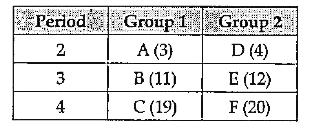There are three elements E, F, G with atomic numbers 19, 8 and 17 respectively.
Classify the elements as metals and non- metals.
To classify the elements E, F, and G with atomic numbers 19, 8, and 17 respectively as metals or non-metals, we will analyze their electronic configurations and their tendencies to lose or gain electrons.
1. Identify the Elements:
- Element E has an atomic number of 19.
- Element F has an atomic number of 8.
- Element G has an atomic number of 17.
2. Determine the Electronic Configuration:
- For Element E (atomic number 19):
- The electronic configuration is 2, 8, 8, 1.
- For Element F (atomic number 8):
- The electronic configuration is 2, 6.
- For Element G (atomic number 17):
- The electronic configuration is 2, 8, 7.
3. Analyze Element E:
- Element E has 1 electron in its outermost shell (valence shell).
- Metals tend to lose electrons easily. Since E can lose this one electron, it is classified as a metal.
4. Analyze Element F:
- Element F has 6 electrons in its outermost shell.
- Non-metals tend to gain electrons to complete their outer shell. Since F can gain 2 electrons to achieve a full outer shell (8 electrons), it is classified as a non-metal.
5. Analyze Element G:
- Element G has 7 electrons in its outermost shell.
- Similar to F, G can gain 1 electron to complete its outer shell. Therefore, it is also classified as a non-metal.
Final Classification:
- Element E (atomic number 19) is a metal.
- Element F (atomic number 8) is a non-metal.
- Element G (atomic number 17) is a non-metal.
- Element E has an atomic number of 19.
- Element F has an atomic number of 8.
- Element G has an atomic number of 17.
- For Element E (atomic number 19):
- The electronic configuration is 2, 8, 8, 1.
- For Element F (atomic number 8):
- The electronic configuration is 2, 6.
- For Element G (atomic number 17):
- The electronic configuration is 2, 8, 7.
- Element E has 1 electron in its outermost shell (valence shell).
- Metals tend to lose electrons easily. Since E can lose this one electron, it is classified as a metal.
- Element F has 6 electrons in its outermost shell.
- Non-metals tend to gain electrons to complete their outer shell. Since F can gain 2 electrons to achieve a full outer shell (8 electrons), it is classified as a non-metal.
- Element G has 7 electrons in its outermost shell.
- Similar to F, G can gain 1 electron to complete its outer shell. Therefore, it is also classified as a non-metal.
- Element E (atomic number 19) is a metal.
- Element F (atomic number 8) is a non-metal.
- Element G (atomic number 17) is a non-metal.
Topper's Solved these Questions
Similar Questions
There are three elements E, F, G with atomic numbers 19, 8 and 17 respectively.
Give the molecular formula of the compound formed between E and G and state the type of chemical bond in this compound.View SolutionAtomic number of an element is 16. State
Is the element a metal or a non-metalView Solution
Knowledge Check
- Question 1 - Select One
Three elements X , Y and Z have atomic numbers 19 , 37 and 55 respectively . Then the correct statement (s) is / are
ATheir ionization potential would increase with increasing atomic number.BY would have an ionization potential between those of X and Z.CZ would have the highest ionization potential.DY would have the highest ionization potential. - Question 2 - Select One
Three elements 'X', 'Y' and 'Z' have atomic numbers 18, 19 and 20 respectively. How many electrons are present in the M shell of these elements?
A8,9,10B8,10,13C8,8,8D8,9,12
The elements A, B, C, D and E have atomic number 9, 11, 17, 12 and 13 respectively. Which pair of elements belongs to the same group ?
View SolutionElements A, B and C have atomic numbers 9, 10 and 20 respectively. State which one is
(i) a metal
(ii) non-metal
(iii) chemically inert.
Explain the formation of bond between any two elements. Draw its orbital diagram. Name the type of bond.View SolutionIn the table given below, six elements are shown with their atomic numbers given in parenthesis.

State whether element B is non-metal or metal.View SolutionFour elements P, Q, R and S have atomic numbers 12, 13, 14 and 15 respectively. Answer the following questions giving reasons:
(i) What is the valency of Q ?
(ii) Classify these elements as metals and non-metals.
(iii) Which of these elements will form the most basic oxide?View SolutionElement P has atomic number 19. To which group and period, does P belong? Is it a metal or a non- metal ? Why?
View SolutionElements A, B and C have atomic numbers 9, 20 and 10 respectively.
State which one is :
(i) a non-metal
(ii) a metal
(iii) chemically inert.View Solution

